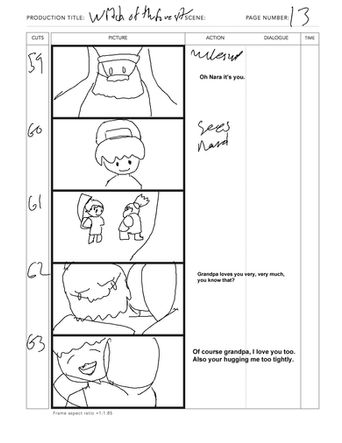

"The Witch of the Forest" is a short hand-drawn animated film using Japanese Animation techniques.
The Witch of the Forest

About the Artist
Name: Davis Peng
Hometown: Greenwich CT
Campus: Storrs
Concentration: 2D Animation and Motion Graphics
Medium: 2D Hand-Drawn Animation
Spring Advisor: Heejoo Gwen Kim
Davis Peng is from Greenwich Connecticut, and is a senior at the University of Connecticut, majoring in Motion Graphics and 2D animation in the Digital Media and Design department. He is currently serving as the Chief Operations Officer for the University of Connecticut Television, the student-run television department on campus. Davis has started an independent animation studio with his high school friend Charlie Callahan. Davis also hosts a podcast with Charlie about the current industry and talks about movies, animation, and the current state of the entertainment industry.
.png)
Synopsis
An old traveler seeks out a witch that can grant the dreams of a person, his journey leads him to a forest, where the witch lives. As he walks further into the woods, it starts to rain. He runs to seek shelter under a towering tree, and he finds a large cave under its roots. He takes shelter and he meets a small girl. Who is this small child? And what is she doing out so far in the woods?
Scan for a mobile version
Trailer
Artist Statement
The main theme of The Witch of the Forest is bonds and kindness, which is shown through the relationship of the main characters. In the story, the main characters develop a bond through sharing acts of kindness for each other. The overall style is meant to be 80’s style anime where in my composited scenes I have made adjustments to give it a retro feel. The Traveler, and The Girl. In the story, The Traveler shows kindness and cares for The Girl, and at the same time, The Girl acts as a pseudo grandchild to The Traveler. Being able to care for and be kind to The Girl gives fulfillment to his life. For my project, I have adapted and used the Japanese animation workflow or the Anime pipeline workflow in making my animation. I have incorporated a Japanese style of storyboards called “Econte”, which allowed me to include SFX and camera movements directly into the storyboards. Traditional storyboards for western animations would only have these elements included in the animatic stage. The next step in the process is what is referred to as “LO” or layouts which are basically white-colored in images that allow the douga artists (inbetweeners) to trace and draw correctly.
This project was made using the Japanese Animation work pipeline.
Project Work Flow
Script Writing
I originally wrote a completely different script for my final project. That project started to get too long, and I fell out of love with the project, and will go back to it later. But when writing the script for, "The Witch of the Forest" I made a harder effort to show the Japanese work pipeline, as well as the theme of family, and kindness.
Econte (Story Boards)
Econte (storyboards) is how the Japanese Anime industry does its preproduction work where they have vertical boxes to help detail camera tilts, and other movements. In Econte you are able to do more camera movements, as well as insert SFX and lines on the right-hand side. In the western industry, storyboards serve as a general guide map for the animatic and sometimes be shot for shot based on the amount of time they have in the preproduction schedule.
Animatic
The animatic can be drawn very differently based on the studio, and the timeframe of what they need to push out. The animatic is really more for the voice actors to use as a reference for the script when recording. For my animatic, I did the key frames first and then tried to dub over the mouth flaps for some of the characters. This is more inline with actual dubbing of cartoons, and animation.

Genga (Key Frames)
The next step in the process is called, "Genga" these are the keyframes for the animation. Depending on the animator, they will sometimes do more keys in an animation based on the voice actor's performance. They will also have to write down the keyframe and where it is in the timeline. This is called the timesheet, and it gives more info to the inbetweeners on where to draw the in-betweens. In my work pipeline since I'm doing both the keys and in-betweens, I did not use a time sheet. Genga animators actually have to draw the backgrounds, and the background artist will color and texture it further down the pipeline. I did all the keyframes, and then to speed up the process for the inbetweening and layouts I combined the usual process of the test animations with clean-up work.

LO (Layouts)
Layouts are a more clean version of the keyframe animations, and these will be used for the inbetweening and coloring process. In my process, I combined the LO and initial Genga for the project.

Douga (Inbetweens)
Douga is one of the final steps for the physical drawing aspect for the Japanese Animation workflow. Here the douga artists use the curve tool to trace the key frames and then draw the in-betweens for each individual frame. Depending on the timesheet of the keyframe animator they may ask you to use two's but the industry standard for animation is three's

Coloring
Coloring is the last step of the drawing pipeline, colorist will use the douga lines and fill in the colors using the character sheets so that the colors are consistent for the character across the project.

Compositing
Compositing is the final step to add the necessary lighting and glow effects for certain scenes. From there it would be sent to the audio designer who will then add the necessary sound effects, sounds, and voices, then they will put it together in the final timeline and export it.














